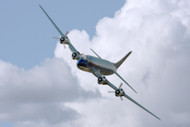Aircraft Wings Need to Be More Flexible
By on Nov 8th 2017
As part of the journey to building more fuel-efficient aircraft, aeronautic engineers have extensively researched ways to modify aircraft wings and make them more flexible.
Less rigid wings could be the key to these flights because the overall weight of the aircraft would decrease while flexibility would increase.
NASA's Advanced Air Transport Technology project and NASA's Flight Demonstration capabilities project is behind the endeavor. They prepared a test flight employing new technology with the X-56. The plane's long, flexible wings are similar to what the finished version of a flexible-wing plane would look like. However, one obstacle engineers would need to overcome in order to design a safe plane is flutter.
The Flutter Fear
In aeronautic and civil engineering, flutter tests must be done to ensure the plane is structurally sound when exposed to high-wind and high-speeds.
Fluttering occurs when vibrations equal to the structure's natural frequency travel through the aircraft. As a result, waves become larger causing structural damage and sometimes failure.
It occurs in other massive structure as well. On November 7, 1940, the Tacoma Narrows Bridge collapsed because of it. The bridge had problems from the start-it moved up and down while it was still under construction. Engineers installed more cables and other devices to try and lessen the movement, but it ultimately failed.
The event further proved how dangerous fluttering can be when dealing with large-scale structures. Past video footage of failed flutter tests on flights have shown the vibrations, referred to as oscillations, becoming so strong that the aircraft bends as if it's made of rubber.
Making Aircraft More Aviary
Flights like the X-56 are more vulnerable to flutter because of how thin the wings are. Technology to overcome the flutter and make the aircraft fly more like birds is a main goal of engineers.
NASA and MIT engineers teamed up to make a shape-shifting wing that would ultimately replace the use for flaps, ailerons, and winglets. It could also allow the plane to fly quieter and smoother, in addition to increased fuel efficiency.
In order to do this, the entire make-up of an airplane wing had to be re-designed. There are eight pieces to the flexible wings and each piece has their own level of stiffness. These blocks are placed in a specific pattern, and two small motors make it possible for the wing to twist. Such twisting motion allows it to adapt while cutting through the constantly changing air.
Looking ahead, employing the wings on a full-size aircraft will be a balancing act between flexibility and strength. Although these block-wings are adaptable, they do not have the rigor to carry the amount of weight a traditional aircraft does. Scientists project further testing to be done on unmanned aircraft and drones.
Learn about NASA's other endeavor to cut down on flight time!
Sources:
https://www.nasa.gov/centers/armstrong/features/highly_flexible_wings_tested.html
https://www.wired.com/2016/11/nasas-mighty-morphing-wings-make-efficient-flying/
https://www.nasa.gov/press-release/nasa-successfully-tests-shape-changing-wing-for-next-generation-aviation
https://www.aps.org/publications/apsnews/201611/physicshistory.cfm
https://www.wired.com/2010/03/flutter-testing-aircraft/







